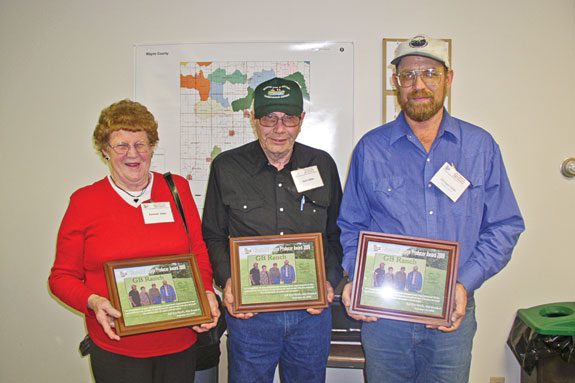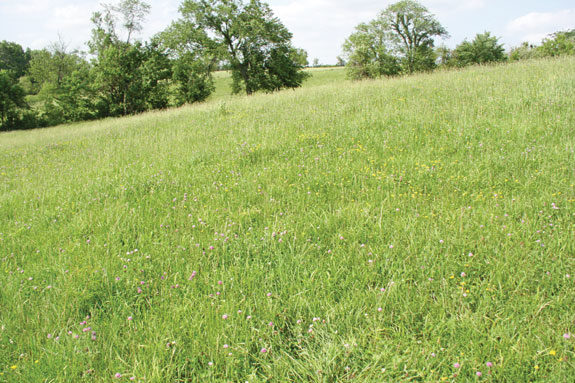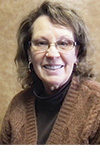The delight he gets from seeing the diverse, healthy forage his cattle are grazing every day is also reflected in comments made by the Natural Resources Conservation Service (NRCS) district conservationist and Iowa State University Extension specialist he’s consulted with in recent years.
“I’ve been a little astounded sometimes at the quality of Gene’s soil and the quality of his forage,” Mark Fehseke, Wayne County (Iowa) NRCS district conservationist, says.
“It’s been a couple of years ago that Gene invited me over to take a look at the legumes in his paddocks. They were so plentiful. I typically carry a 12-inch soil probe with me when I make this kind of visit so I can see what the soils are like.
Gene and I were both surprised at how easily the probe penetrated the soil, a sign of plentiful organic matter.
We discovered a root at that 12-inch depth that was similar to what you’d find on more fertile land. That was great and a little surprising.”
Gibbs and Fehseke also found Eastern gamagrass in the paddocks, which is nearly unheard of in Iowa.
The warm-season bunch grass is native to the eastern United States and is still often found east of Kansas and Oklahoma.
It was once found extensively throughout the U.S., but now is rarely found in large, natural stands. Native buffalo and elk used to graze the now-rare forage before it was grazed out by domestic livestock.
“The first clump I spotted in Gene’s paddock was headed out with seed,” Fehseke says. “I started looking around for more and found several more similar clumps; each one seemed a bit larger than that first one.
The largest stand of the gamagrass was on a sloping hill. That was also all headed out. You have to be a really good manager to maintain Eastern gamagrass in a cool-season pasture.”
Rest periods that allow regrowth are critical to cultivating quality forage. That management practice is built into Gene’s grazing rotation plan as he works through each of his 13 paddocks.

His cattle graze small areas, which result in trampling some of the forage so it’s returned to the soil, building organic matter. He also moves the cattle before forage is grazed too severely.
“Grazing studies have shown that taking about 50 percent of a plant for grazing will result in loss of about 5 percent of the root structure of that plant,”
Fehseke says. “Removing 60 percent of the plant will result in loss of half the root structure. Grazing over 80 percent of the plant means losing the entire root structure.
Gene’s rotation plan is working well for him because my soil probe revealed very healthy root structure at a soil depth of 12 inches. That, combined with the quality of organic matter here, is what’s providing such lush forage.”
Soils on Gene’s ranch are weathered glacial till soils with some leached loess soils, all tending to have high clay subsoil. It’s substantially different than the typically silty soil found in other parts of Iowa.
“The main difference between soils like those found at GB Ranch and most other soils in Iowa is how rain is absorbed into the soil,”
Fehseke says. “It will soak through the silty soils much more readily. Because Gene has such high organic matter in his soils, he’s capturing a lot of the rain that would probably runoff otherwise and be needed later in the season.”
In the initial stages of developing his grassland, Gene used lime to bring his soil pH to 6.5 percent. That was the environment his legumes needed in order to thrive.
“When we first moved here, the clay soil was yellow and it hung on our boots so much we could hardly pick up our feet after walking through it a ways,”
Gene says. “Now it’s mostly gray on the top three to four inches of the soil. That’s the result of the cows trampling some of the forage as they graze. They also ensure good nutrient distribution. We also graze as much as we can during winter, which keeps nutrients on the grass, too.”
Managing the fescue in Gene’s fields has also been accomplished through rotation.
“Trefoil and red clover also help reduce the fescue toxicity,” Gene says.
Gene doesn’t need to reseed any forage in his pastures. The soil quality provides what forages need to grow and they appear in response to the rotational grazing.
Joe Sellers, Iowa State University Beef Program specialist, says the Gibbs family has realized such success with their forage because it’s their primary focus and they have implemented what they’ve learned over the years about the benefits of soil conservation practices.
“Both Gene and his wife, Ramona, have been involved with soil and water conservation for quite a few years,”
Sellers says. “They received the 2009 Iowa Forage and Grassland Council’s Livestock Forage Producer Award.
Three of their key principles are that they have adequate acres, don’t overgraze and have long rest periods for their paddocks.
A lot of people don’t use the conservation principles they’ve learned as well as the Gibbs family has. For those raising crops, their focus is split between forage and crop production and the forage sometimes suffers.”
Gene and his sons, Michael and Ed, have worked together on the ranch, serving as cooperators on Iowa State University forage demonstrations and research projects.
Sellers says rising feed and pasture lease costs might push more livestock producers to review their forage production plan.
“It’s not as easy to find pasture, so there’s likely to be more interest in fine-tuning forage production and getting the most out of every acre to help reduce feed costs,”
Sellers says. “The quality of Gene’s forage also helps with weed and brush control. That’s not an issue at GB Ranch.”
Gene and his wife, Ramona, began developing GB Ranch in the early 1970s. Gene says they purchased the land with the idea of producing forage to raise beef.
“We have always preferred that type of operation rather than raising corn and soybeans,” Gene says. “It eliminates the expense you have for machinery when you plant crops. Input costs are much less, too.”
Gene, Ramona, their sons and their sons’ wives (Michael and Nita Gibbs of Promise City and Ed and Danette Gibbs of Allerton) run 1,200-pound Angus females for their cow/calf operation.
Over the years, as they developed their grazing system, they strategically established several ponds amongst the paddocks as a water resource.
Fehseke says implementation of the principles they’ve learned has led the Gibbs family to realize such success.
“They really have a well-managed system,” Fehseke says. “They have a lot of knowledge about forage production and a thorough understanding of how their system works.
As I and other conservation specialists work with Gene, we’re all learning from one another. Gene reads a lot of materials related to forage production and tests out new ideas from time to time.
He’s gained a great deal of knowledge just from working so closely with his system all these years.”
Sellers says their success can be reproduced with an investment of the time and effort the Gibbs family has demonstrated.
“They’ve been so good to share what they learn and take part in events like pasture walks and research projects,”
Sellers says. “They’re a great model for other forage producers. They take pasture management seriously and, to them, soil conservation is a big deal.
They’ve learned and have demonstrated to all of us that little things make a big difference.” FG
Loretta Sorensen is a freelance author with Prairie Hearth Publishing, LLC in Yankton, South Dakota.
PHOTOS
TOP When Gene Gibbs bought his farm near Promise City, Iowa in 1973, the forage there was mostly fescue. He and his wife Ramona created a conservation plan and began interseeding legumes in the 80s and 90s, intensifying their grazing rotation in the early 90s. The result is a lush blanket of forage that continues to provide high-quality feed for their livestock and promotes organic matter in their soils.
BOTTOM: Gibbs family left to right: Ramona, Gene and Mike all received the 2009 Iowa Forage and Grassland Council’s Livestock Forage Producer Award. Photos courtesy of the Gibbs family.












